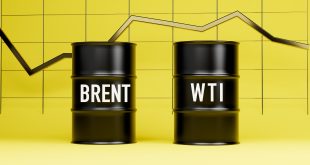Oil prices edged lower on Monday, pressured by a strong U.S. dollar and market anticipation of upcoming key economic data and Federal Reserve policy signals. Concerns over sanctions on Iranian and Russian oil also weighed on sentiment, despite recent price gains supported by cold weather and fiscal stimulus measures in China.
Key Oil Price Movements
- Brent Crude Futures: Fell 21 cents, or 0.3%, to $76.30 a barrel as of 04:45 GMT. This follows Friday’s close at its highest level since October 14.
- West Texas Intermediate (WTI) Crude: Declined 19 cents, or 0.3%, to $73.77 a barrel, after Friday’s peak since October 11.
Dollar Strength Pressures Oil
A robust U.S. dollar, trading near a two-year high, has raised the cost of dollar-denominated commodities like oil, making them less attractive to global buyers.
- Investor Outlook: Priyanka Sachdeva, senior market analyst at Phillip Nova, emphasized that the strong dollar remains a critical factor restraining oil prices.
Upcoming Economic Data in Focus
Investors are looking ahead to:
- Fed Meeting Minutes (Wednesday): Insights on future rate hikes or cuts.
- December Payrolls Report (Friday): A potential indicator of energy consumption trends in the U.S.
Sanctions and Supply Concerns
- Iranian and Russian Oil:
- The Biden administration is preparing to intensify sanctions on Russia to curb its oil revenues, targeting tankers carrying Russian crude.
- Goldman Sachs anticipates Iranian oil production could drop by 300,000 barrels per day (bpd) to 3.25 million bpd by Q2, amid tighter sanctions from the U.S.
- OPEC and Non-OPEC Production:
- U.S. oil output may see further increases under policy adjustments by the incoming Trump administration, potentially adding to a global supply surplus.
- Baker Hughes reported a slight decline in the U.S. oil rig count, down by one to 482 rigs last week.
Market Sentiment
The global oil market remains clouded by a projected supply surplus this year, with rising non-OPEC production likely offsetting any increases in demand. Analysts remain cautious as they monitor geopolitical developments, including Western sanctions and potential policy shifts by major oil-producing nations.
Outlook
While colder weather and Chinese fiscal stimulus have supported prices recently, oil markets face headwinds from a strong dollar, geopolitical uncertainties, and a potential global supply glut. This week’s Fed updates and U.S. labor data will likely provide additional direction for oil prices.
The oil market is currently navigating a delicate balancing act between robust demand and potential supply disruptions. While lower interest rates in the United States and other major economies are expected to support oil consumption, geopolitical risks loom large. The recent escalation of tensions in the Middle East, particularly the Houthi threat to Saudi Arabia, has heightened fears of potential supply disruptions, adding another layer of uncertainty to the oil market.
The potential for unforeseen geopolitical events to disrupt oil supplies remains a constant threat. Even minor incidents in oil-producing regions can significantly impact global supply chains, leading to price volatility. This underscores the inherent fragility of the global oil market and highlights the importance of robust contingency plans to mitigate the impact of such disruptions.
The Road Ahead: Navigating a Complex Landscape
As we enter 2025, the oil market will continue to navigate a complex landscape. The interplay between global economic growth, Chinese economic recovery, the ongoing energy transition, and geopolitical risks will significantly influence price movements.
The potential for increased volatility is high. While robust demand provides a supportive backdrop for oil prices, the threat of supply disruptions and the ongoing uncertainty surrounding China’s economic trajectory could lead to significant price swings.
The year 2024 in the oil market was a year of contradictions. While global demand surged to record highs, defying expectations, the year ended with prices largely stagnant. As we move into 2025, navigating the complexities of the global energy landscape will be crucial. Market participants will need to closely monitor geopolitical developments, assess the impact of economic policies in major oil-consuming countries, and adapt to the evolving energy landscape to effectively manage risks and capitalize on opportunities.
 Noor Trends News, Technical Analysis, Educational Tools and Recommendations
Noor Trends News, Technical Analysis, Educational Tools and Recommendations





